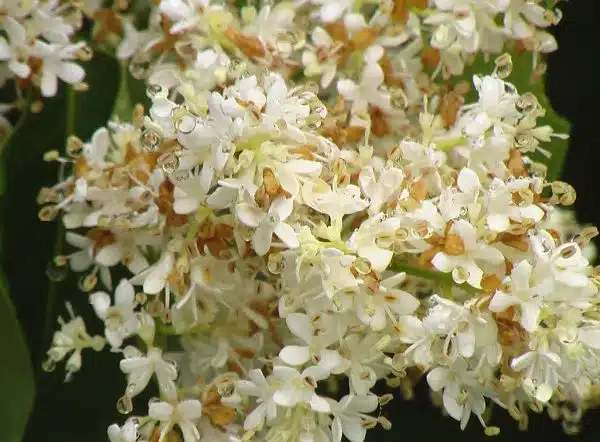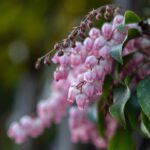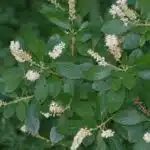The Japanese mockorange, scientifically known as Philadelphus coronarius, is a highly sought-after plant for its stunningly beautiful white flowers and sweet fragrance. This deciduous shrub is native to southern Europe and Asia and can grow up to 8 feet tall with an equal spread. Growing the Japanese mockorange requires dedication and care, but the rewards are well worth it.
As a seasoned Japanese mockorange growing expert, I am excited to share my knowledge about this wonderful plant. In this article, I will provide a comprehensive profile of the Japanese mockorange, including its preferred growing conditions, maintenance requirements, and tips for ensuring optimal growth. Whether you are a beginner or an experienced gardener looking to expand your repertoire of plants, this guide will provide valuable insights into cultivating one of nature’s most beautiful offerings.
Description And Characteristics Of The Japanese Mockorange
Imagine a plant that exudes elegance and subtleness, much like the graceful movements of an experienced dancer. Such is the beauty of the Japanese Mockorange, a flowering plant that has made its mark in landscaping across the world. Its unique features and stunning appearance have captured the attention of garden enthusiasts and landscapers alike, making it one of the most sought-after plants in the market.
The Japanese Mockorange or Philadelphus coronarius, as it is scientifically known, is native to Japan but has since been introduced to other parts of Asia, Europe, and North America. It is a deciduous shrub that grows up to 10 feet tall with arching branches that form a fountain-like shape. The leaves are dark green with serrated edges while its flowers are white with yellow centers and emit a sweet fragrance similar to that of orange blossoms.
One of the unique features of this plant is its ability to attract bees and butterflies due to its sweet-smelling flowers. Its aesthetic appeal combined with its economic importance makes it an essential addition to any landscape design project. Moreover, it requires minimal maintenance and can survive in various soil types and climate conditions, making it an ideal choice for both residential and commercial spaces.
With such characteristics as these, it’s no wonder that growing Japanese Mockorange has become increasingly popular among those looking for ways to enhance their gardens or landscapes. In the next section, we’ll explore some benefits associated with growing this magnificent plant.
Benefits Of Growing Japanese Mockorange
Benefits of Growing Japanese Mockorange:
Japanese mockorange is a beautiful shrub that offers many benefits to the gardener. It has fragrant white flowers that bloom in the summer, and its dark green foliage adds color and texture to any garden. One of the main benefits of growing Japanese mockorange is its ease of cultivation. This shrub can thrive in a wide range of soils and climates, making it an excellent choice for gardeners of all skill levels.
Another benefit of growing Japanese mockorange is its low maintenance needs. Once established, this shrub requires little watering or fertilizing, making it a great addition to busy landscapes or low-water gardens. Additionally, pruning can be done after flowering to maintain shape and size, but it’s not necessary for the health of the plant.
Cultivation techniques for Japanese mockorange are straightforward and easy to follow. They include planting in well-draining soil with good sunlight exposure, regular watering during establishment, and mulching around the base to retain moisture. With proper care, this shrub can live for many years and provide beauty to any garden or landscape.
As gardening enthusiasts know very well, choosing the right location for growing Japanese mockorange is crucial to their success. In the next section, we will discuss some important factors to consider when selecting a site for your shrubs’ growth.
Choosing The Right Location For Growing Japanese Mockorange
Having understood the benefits of growing Japanese Mockorange, it is important to choose the right location for optimal growth. One of the most critical factors to consider when selecting a location is sun exposure. Japanese Mockorange thrives in full sunlight and requires at least 6 hours of direct sunlight per day. Insufficient sun exposure can result in stunted growth, reduced blooms, and decreased fruit production.
Another essential factor to consider when choosing a location for growing Japanese Mockorange is soil type. The plant prefers well-draining soil that is rich in nutrients. It does not thrive in soils with high alkalinity or salinity levels. It is also crucial to avoid waterlogged soils as they can lead to root rot, which can be detrimental to the plant’s health.
When selecting a site for your Japanese Mockorange, it is essential to ensure that it is not subject to extreme weather conditions such as frost or strong winds. These conditions can cause damage, stunt plant growth or even kill the plant altogether. Once you have identified an appropriate site for your Japanese Mockorange, you can proceed with planting and take necessary measures like mulching and watering regularly.
To ensure healthy growth of your Japanese Mockorange, it’s advisable to understand soil requirements for growing this shrub. Soil quality will determine how well your plant adapts and grows over time. Understanding these requirements will allow you to provide adequate care and maintenance that will enhance its overall health and productivity.
Soil Requirements For Growing Japanese Mockorange
- The optimal soil pH for growing Japanese Mockorange ranges between 5.5 and 7.5.
- The soil must be well-draining and should not be allowed to remain soggy or waterlogged.
- Fertilization with nitrogen-rich fertilizer is important for encouraging healthy foliage growth and flower production.
- Applying a slow-release fertilizer or a foliar fertilizer once per season is recommended.
- Adding an organic matter such as compost or peat moss will improve the drainage of clay soils and provide additional nutrients for growth.
- Mulch can also be used to help retain soil moisture and reduce weed growth.
Soil Ph
To achieve a thriving Japanese Mockorange, it is essential to understand the soil requirements. Soil pH is one of the essential factors that determine whether your plant will flourish or wilt. Benefits of maintaining ideal acidity levels in the soil include improved nutrient uptake, which boosts growth and overall plant health.
Japanese Mockorange thrives in slightly acidic soil with a pH ranging between 5.5 to 6.5. Alkaline soil may hinder nutrient uptake, leading to stunted growth or yellowing leaves. The plant requires well-draining soil that retains moisture but does not become waterlogged.
Regularly testing the soil’s pH levels ensures your Japanese Mockorange receives optimal conditions for growth and development. Adding organic matter like compost can help regulate soil acidity levels, ensuring an ideal environment for your plant to thrive without relying on artificial adjustments.
Remember that healthy plants require a balanced environment that meets their unique needs. By learning about the benefits of maintaining optimal acidity levels and understanding how nutrients uptake works in alkaline soils, you can cultivate a robust Japanese Mockorange that adds beauty and fragrance to your garden for years to come.
Soil Drainage
As a Japanese mockorange growing expert, it is crucial to understand the soil requirements for cultivating healthy plants. In addition to maintaining optimal acidity levels, improving drainage is also essential. Japanese mockorange requires well-draining soil that retains moisture but does not become waterlogged. Poorly draining soil can lead to root rot and other issues that may stunt growth or even kill the plant.
Soil testing is an effective way of determining your soil’s drainage capacity. A simple test involves digging a hole about 30cm deep and filling it with water. If the water takes more than an hour to drain, your soil has poor drainage and requires improvement. On the other hand, if the water drains too quickly, you may need to add organic matter like compost or mulch to retain moisture in the soil.
Improving drainage can be achieved by adding amendments like sand or gravel to your soil mix. These materials help increase porosity and allow excess water to drain freely from the roots, preventing waterlogging. It is essential to ensure proper drainage for your Japanese mockorange as it helps prevent disease and encourages healthy root development, ultimately leading to robust growth and beautiful blooms.
Soil Fertilization
As a Japanese mockorange growing expert, I understand the importance of providing the right soil requirements to ensure healthy plant growth. Aside from proper drainage, soil fertilization is also essential in promoting optimal plant health. Fertilization ensures that the plants receive adequate nutrients that they may not receive naturally from the soil.
Composting techniques are an excellent way to provide organic amendments to the soil, which helps improve overall soil quality and fertility. Organic amendments such as composted manure or kitchen scraps contain essential nutrients such as nitrogen, phosphorus, and potassium that promote healthy plant growth. These organic materials help increase beneficial microbial activity in the soil, which breaks down nutrients for plant absorption.
Applying organic amendments should be done before planting or during the growing season as a top dressing. The amount of fertilizer needed depends on factors such as soil type, plant age, and species. Over-fertilizing can lead to excessive vegetative growth at the expense of blooming performance. As a Japanese mockorange grower, it is crucial to monitor and adjust fertilization practices accordingly to ensure optimal growth and bloom production for these beautiful plants.
Watering And Fertilizing Japanese Mockorange
Watering and fertilizing are essential aspects of growing healthy and vibrant Japanese mockorange. Proper watering frequency is crucial, as overwatering or underwatering can negatively affect the plant’s growth and development. It’s important to water the plant deeply but infrequently, allowing the soil to dry out slightly between watering sessions. Typically, Japanese mockorange requires watering once a week during moderate temperatures and twice a week during hotter weather.
Fertilizing is equally important for promoting healthy growth and flowering in Japanese mockorange plants. The best fertilizer types for this plant are those high in phosphorus, which promotes flower production. A slow-release fertilizer applied in early spring can provide adequate nutrition throughout the growing season. Be sure to follow the manufacturer’s instructions when applying fertilizer, as over-fertilization can cause damage to the plant.
Proper watering and fertilizing of Japanese mockorange plants will contribute significantly to their overall health and beauty. However, it’s important to note that pruning and maintenance are also necessary for optimal growth and flowering. In the next section, we will discuss how to properly prune and maintain your Japanese mockorange plant for long-term success.
Pruning And Maintenance Of Japanese Mockorange
Due to its fast growth rate, Japanese mockorange requires regular pruning to maintain its shape and size. Pruning techniques that are commonly used for this shrub include trimming back any diseased or dead wood, thinning out crowded branches, and cutting back new growth by one-third annually.
To prevent disease from spreading throughout the plant, it is important to sanitize your pruning tools before and after each use. This can be done by wiping them down with rubbing alcohol or a solution of one part bleach to nine parts water. Additionally, avoid pruning when the plant is wet as this can also spread disease.
Regular maintenance of Japanese mockorange can help prevent common pests such as aphids and spider mites from infesting the plant. It is recommended to inspect the plant regularly for signs of infestation and to remove any affected leaves or branches immediately. In cases of severe infestations, insecticidal soap or neem oil may be necessary.
Moving forward, it is important to keep in mind proper pruning techniques and disease prevention strategies in order to maintain a healthy and thriving Japanese mockorange shrub. However, even with these measures in place, common pests and diseases may still occur. The following section will delve into these issues further and provide guidance on how best to handle them.
Common Pests And Diseases Of Japanese Mockorange
Aphids are a common pest of Japanese Mockorange and can be identified by the presence of small, soft-bodied insects that may cause yellowing or curling of the leaves. Leaf Spot is a fungal disease of Japanese Mockorange caused by a variety of fungi that can result in dark spots on the leaves. Root rot is a fungal disease of Japanese Mockorange caused by a variety of fungi that can result in the wilting of the foliage. Cultural practices, such as proper irrigation and avoiding excess nitrogen fertilizer, can help reduce the risk of aphids, leaf spot, and root rot. Chemical control of aphids, leaf spot, and root rot may be necessary in some cases. Regular monitoring of Japanese Mockorange for signs of aphids, leaf spot, and root rot is necessary for successful prevention and management.
Aphids
Aphids are a common pest in Japanese mockorange plants. These tiny insects feed on the sap of the plant, causing leaves to yellow and curl. Aphids reproduce quickly, making it necessary to control them as soon as they are detected.
To control aphids, natural predators such as ladybugs and lacewings can be introduced into the garden. These predators feed on aphids and help keep their population under control. Organic control methods such as neem oil or insecticidal soap can also be used to eliminate aphids. These options are safe to use around people and pets while effectively controlling the aphid population.
In summary, it is important to monitor Japanese mockorange plants for aphids regularly. Natural predators and organic control methods are great options for keeping these pests at bay without harming the environment or nearby creatures. By implementing these measures, one can enjoy a healthy and thriving Japanese mockorange plant.
Leaf Spot
Japanese mockorange plants are susceptible to various pests and diseases that can affect their growth and overall health. One of the most common diseases that afflict these plants is leaf spot, a fungal infection that causes dark spots on the leaves. Leaf spot can weaken the plant’s ability to photosynthesize, leading to stunted growth and discolored foliage. As a Japanese mockorange growing expert, it is crucial to understand how to prevent and treat leaf spot effectively.
Preventing leaf spot recurrence involves maintaining proper cultural practices such as avoiding overhead watering, providing adequate air circulation, and removing fallen leaves from the ground. Additionally, it is essential to monitor the plant regularly for any signs of disease or pest infestation. Treating leaf spot can be done through fungicidal sprays or organic treatments such as neem oil or copper-based products. These methods can help eliminate the fungus causing the disease while preventing further damage to the plant.
In conclusion, leaf spot is a common disease that affects Japanese mockorange plants. As with any other plant disease, prevention is always better than cure. By following proper cultural practices and regular monitoring of the plant, one can prevent leaf spot from recurring. If detected early enough, treating leaf spot with fungicidal sprays or organic treatments can help save an infected plant from further damage.
Root Rot
Another common disease that Japanese mockorange plants are susceptible to is root rot. Root rot is a fungal infection caused by overly moist soil conditions, leading to the decay of the plant’s roots. Once infected, the plant can no longer absorb nutrients and water, resulting in yellowing leaves, stunted growth, and ultimately death.
Preventing root rot involves maintaining proper watering practices such as not overwatering or allowing the soil to dry out completely. It’s also essential to ensure proper drainage of the soil and avoid planting in areas with poor drainage. Additionally, using well-draining soil and avoiding overcrowding of plants can help prevent root rot from occurring.
Treatment options for root rot include removing any infected plant material and improving soil drainage. Fungicidal treatments can also be used to eliminate the fungus causing the infection. However, prevention methods are always better than treatment options when it comes to dealing with root rot since it can be challenging to eradicate entirely once established.
In summary, root rot is a fungal infection that commonly affects Japanese mockorange plants. Preventing its occurrence through proper watering practices and ensuring good soil drainage is crucial in maintaining healthy plants. If detected early on, treatment options such as fungicidal sprays or improving soil drainage can help save an infected plant from further damage.
Propagation Methods For Japanese Mockorange
To propagate Japanese mockorange, there are several methods to choose from. One of the most popular techniques is air layering, which involves wrapping a section of the stem with moist soil until it develops roots. This method is useful for mature plants that have thick stems and can take up to a year to produce new plants. The division technique for propagation is also an effective way to grow Japanese mockorange by separating healthy rhizomes from the parent plant.
The best time for propagating Japanese mockorange by cuttings is during early spring when the new growth begins to emerge. Cuttings should be taken from healthy branches that are free from disease and pests, and they should be about 6 inches long with at least three nodes. Layering is another propagation technique that involves bending a low-hanging branch down to the ground and burying a section under soil until it develops roots. This method can take a few months to produce new plants.
In summary, successful propagation of Japanese mockorange requires careful consideration of the different techniques available. Air layering and division techniques are both effective methods for growing new plants, while cuttings or layering are best done during early spring when new growth is emerging. By choosing the right time and method for propagation, anyone can enjoy growing these beautiful shrubs in their garden. In the next section, we will address some frequently asked questions on how to grow Japanese mockorange successfully.
Frequently Asked Questions About Growing Japanese Mockorange
Japanese Mockorange is a popular garden shrub, known for its fragrant white flowers and bright green foliage. Planting in a sunny area with well-drained soil is essential for optimal growth and blooming. Adequate watering is necessary, though it is important to avoid overwatering due to the plant’s susceptibility to root rot. Pruning Japanese Mockorange is best done in the early spring and can be done to maintain the desired shape of the shrub and to encourage more blooming. Deadheading spent flowers can also help to achieve better blooming. To maximize the full potential of the Japanese Mockorange, it is recommended to fertilize the soil annually in the early spring.
Planting Conditions
Growing Japanese mockorange, also known as Philadelphus coronarius, is a rewarding experience that requires careful consideration of planting conditions. Best practices should be followed to ensure the success of this plant species. One important factor is the soil pH level, which should be between 6.0 to 7.5. It is imperative to avoid acidic soil conditions as it can lead to stunted growth and poor flower production.
Another critical aspect when planting Japanese mockorange is the amount of sunlight it receives. This shrub thrives in full sun or partial shade conditions, which means that it needs at least six hours of direct sunlight per day for optimal growth. Common mistakes include planting it in areas with too much shade or not providing enough light, leading to weak stems and reduced flowering potential.
Lastly, watering techniques play a vital role in the health and growth of Japanese mockorange. The best practice is to water deeply once a week rather than shallowly every day as this encourages deep root development and prevents waterlogging, which can lead to root rot disease. In conclusion, by following these best practices and avoiding common mistakes such as planting in acidic soil, insufficient lighting, and improper watering techniques, gardeners can enjoy a flourishing Japanese mockorange shrub for years to come.
Watering Requirements
As a growing expert of Japanese mockorange, one of the frequently asked questions is about its watering requirements. Watering is an essential aspect of plant care, and it can significantly impact the health and growth of this shrub. In general, Japanese mockorange requires regular watering to establish deep roots and encourage healthy growth.
Watering frequency largely depends on the climate, soil type, and rainfall in your area. During hot summer months or dry spells, it is crucial to water deeply at least once a week rather than shallowly every day. This will ensure that the water reaches the root zone where it is needed most. On the other hand, overwatering can lead to waterlogging and root rot disease, which can be detrimental to the plant’s overall health. Therefore, it is vital to maintain proper watering techniques.
To ensure optimal growth and flowering potential for Japanese mockorange, gardeners should also consider other factors such as soil pH level and sunlight exposure. Avoid planting in acidic soils and provide at least six hours of direct sunlight per day for optimal growth. By following these best practices and considering all aspects of plant care, gardeners can enjoy a thriving Japanese mockorange shrub in their gardens for years to come.
Pruning Tips
As an expert in growing Japanese mockorange, another common question I receive is about pruning techniques. Proper pruning can help maintain the plant’s shape and promote healthy growth, leading to more abundant blooms. Timing of pruning also plays a significant role in the overall health of the shrub.
The best time to prune Japanese mockorange is in late winter or early spring before new growth begins. This allows for easier access to the plant’s structure and promotes more vigorous regrowth. When pruning, be sure to remove any dead, diseased, or damaged branches first. Then, focus on shaping the shrub by selectively removing any crossing branches or those that are growing inward towards the center of the plant.
It’s important to note that excessive pruning can lead to a reduction in flowering potential for Japanese mockorange. Therefore, it’s recommended to avoid heavy pruning unless necessary and instead opt for light maintenance throughout the year. By following these tips and timing your pruning appropriately, you can ensure a healthy and vibrant Japanese mockorange shrub in your garden.
Conclusion And Final Thoughts On Growing Japanese Mockorange
As a Japanese mockorange growing expert, I hope this guide has been helpful in understanding how to cultivate and maintain these beautiful shrubs. While they may require some effort and attention, the reward of their fragrant blooms is well worth it.
One important aspect of Japanese mockorange care is pest management. These shrubs can be susceptible to aphids, spider mites, and scale insects. Regularly inspecting for signs of infestation and using appropriate treatments such as insecticidal soap or neem oil can help prevent damage to the plant.
In addition to pest management, seasonal care is also crucial for the health and growth of Japanese mockoranges. Pruning should be done in late winter or early spring before new growth emerges. This helps promote bushier growth and encourages more flowers. Fertilizing in early spring with a balanced fertilizer will also provide necessary nutrients for healthy growth.
- To further enjoy your Japanese mockorange:
- Consider planting them near outdoor living spaces to fully appreciate their fragrance.
- Use their cuttings in floral arrangements to bring the sweet scent indoors.
- Share cuttings with friends or family who appreciate gardening as a thoughtful gift.
As you continue on your journey of growing Japanese mockoranges, remember that patience and consistency are key. By following proper pest management techniques and providing seasonal care, you can enjoy these beautiful shrubs for years to come.
Conclusion
The Japanese Mockorange is a beautiful and fragrant shrub that can add an elegant touch to any garden. With its glossy green leaves and delicate white flowers, it is no wonder why this plant has become increasingly popular among gardeners.
When it comes to growing the Japanese Mockorange, choosing the right location and soil is crucial for its success. This plant prefers well-draining soil and partial shade, making it perfect for gardens with dappled sunlight. Additionally, regular watering and fertilizing can help promote healthy growth and prevent common pests and diseases.
Interestingly, according to a study conducted by the University of Florida, the Japanese Mockorange has been found to have antimicrobial properties that can help fight off harmful bacteria. This not only makes it a beautiful addition to your garden but also a beneficial one for your health.
As a Japanese Mockorange growing expert, I highly recommend this plant for its beauty and practical benefits. With proper care and attention, you can enjoy the sweet fragrance of its blooms while also promoting a healthier environment in your garden.
Image Credits
- “Half blossomed Japanese lilac on rainy day” by *Maroon Michelle* (featured)





























